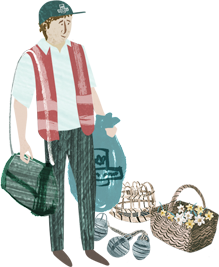Isles of Scilly scented narcissi - fact or fiction?
The questions - just for fun
Test your knowledge of scented narcissi. Which of the following statements are true and which are total balderdash?
You can find the answers further down the page - no peeking!
1. There is a variety of narcissi called Winston Churchill.
2. Narcissi buds are protected by a brown papery sheath called a spathe.
3. On the Isles of Scilly it is an island tradition at New Year to throw a narcissi bulb over the roof of your house to bring good luck.
4. The first narcissi ever to be picked on Scilly was in 1687.

5. All daffodils are narcissi but not all narcissi are daffodils.
6. According to the Guinness Book of Records the tallest daffodil grown on record was 1.55m high.
7. The machine we use to sterilise our narcissi bulbs is called a Jonquiliser.
8. If the narcissi bloom on Chinese New Year, it is said to bring extra wealth and good fortune throughout the year.
9. Narcissi petals can be used to make yellow fabric dye.

The answers - don't peek!
1. There is a variety of narcissi called Winston Churchill - FACT
Along with two roses, a fuchsia and a rhododendron, the British Prime Minister Sir Winston Churchill also had a variety of narcissi named for him. These are beautiful, double flowering, cream narcissi with small orange streaks in the centre. They are one of the later flowering varieties here on Scilly and we usually see them in the fields towards the end of March.

2. Narcissi buds are protected by a brown papery sheath called a spathe - FACT
The spathe is sometimes mistaken for a poorly petal or leaf, but it is actually vital in ensuring that the narcissi buds are protected as they develop.

3. On the Isles of Scilly it is an island tradition at New Year to throw a narcissi bulb over the roof of your house to bring good luck - FICTION
Total balderdash!

4. The first narcissi ever to be picked on Scilly was in 1687 - FICTION
Truth be told we have no idea when the first narcissi was picked on Scilly! Legend has it that some narcissi bulbs were brought over to Scilly as a gift and were mistakenly cooked as onions and thrown out of a window because of their appalling flavour! The discarded narcissi flourished and a new flower on Scilly was born. In 1879 William Trevellick of Rocky Hill Farm, St. Mary's decided to send some of these beautiful flowers to Covent Garden. On receiving an unexpected fortune for the flowers he became one of the first flower farmers on Scilly.
5. All daffodils are narcissi but not all narcissi are daffodils - FACT
There are 13 different classifications of narcissi including daffodils. These catergories are partly determined by flower shape and length, the number of flowers per stem and their flowering season. Here at the farm we specialise in growing the multi-headed Tazetta type of narcissi as they are well known for their beautiful fragrance and abundant number of flower heads. Although many people refer to all narcissi as daffodils they really only make up a small group of the narcissi family. Trumpet and large cupped narcissi are what we traditionally think of as a daffodil whereas the smaller varieties such as Jonquilla and Tazetta are more commonly thought of as narcissi types.
Hence all daffodils are narcissi but not all narcissi are daffodils!
6. According to the Guinness Book of Records the tallest daffodil grown on record was 1.55m high - FACT
A daffodil grown by M. Lowe of Chessell in the Isle of Wight in 1979 reached a height of 1.55m (5 foot, 1 inch). We wish we had known this when Piran found a super tall narcissi quite a few years ago!

7. The machine we use to sterilise our narcissi bulbs is called a Jonquliser - FICTION
We made this one up! Having created the name after our field manager Jon, we realised it was actually quite fitting!
8. If narcissi bloom on the Chinese New Year, it is said to bring extra wealth and good fortune throughout the year - FACT
Tradition holds that if a daffodil is forced to bloom for the Chinese New Year, it will bring luck to the whole household.
9. Narcissi petals can be used to make yellow fabric dye - FACT
Many different types of flowers can be used to make some beautiful dyes for fabric.


